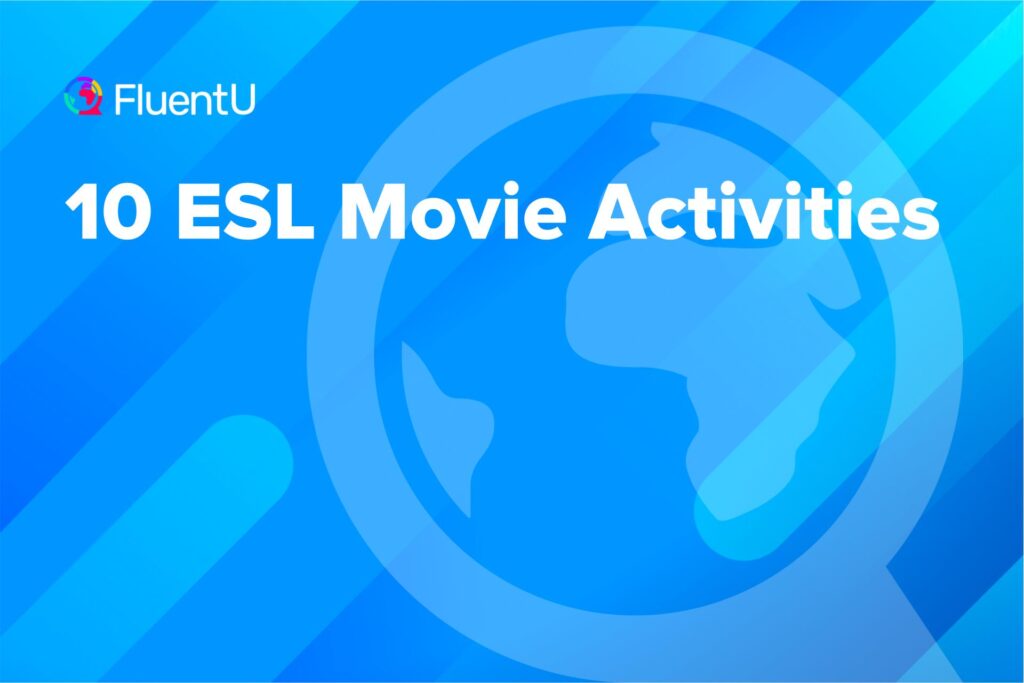10 ESL Movie Activities

Some teachers feel guilty about showing their students movies, thinking: well it’s not really teaching, right?
It’s tempting to think that putting on a movie is simply a great excuse for the teacher to sit at the back of the room, dim the lights and fall asleep clutching the remote.
But it’s not true. Creating a lesson around a popular movie is a guaranteed way to have fun, engage your English learners and gain some much coveted popularity.
Check out this post to read about 10 effective ESL movie activities you can use in your class this semester.
Contents
Download: This blog post is available as a convenient and portable PDF that you can take anywhere. Click here to get a copy. (Download)
How Does Watching a Movie Help ESL Students?
There are countless ways in which movies can support your lesson.
For example, they can be used to:
- Reinforce a grammar point
- Listen for gist
- Practice vocabulary
- Discuss and debate
- Role play
Movies are a brilliant way for students to hear up-to-date authentic speech and be exposed to various accents. And because there are countless movies based on an infinite amount of things, you can use them to introduce or spark discussions about a certain topic, be it a historical event, a time period or the culture of a foreign country.
ESL Movie Comprehension Activities
Movies can be implemented into any lesson, with the purpose of getting students to comprehend and gain meaning from free-flowing speech. Here are five great activities to check comprehension.
1. How Observant Are You?
This activity is good for getting students to talk in the past tense about observation-based facts.
- Before the movie clip, don’t tell the students what they are looking for, but tell them to watch with a keen detective’s eye.
- Afterward the movie, ask them a question about a specific item in a room, or a character’s words or actions.
You can make this a group exercise, getting teams to write their answers together. Repeat as many times as you want!
2. Vocabulary Meaning Match
Use a movie to reinforce or teach vocabulary with this simple activity.
- Give students a worksheet with a list of vocabulary words in one column and scrambled definitions in the other.
- As students watch the movie clip, they have to match the vocabulary to the adjacent list of meanings.
3. Order the Events
This is a reading-based activity, good for building up students’ recall power.
- After watching the clip, give students a set of event cards (no more than ten), in pairs or individually.
Each card should contain one or two sentences of events from the movie clip. These can be as significant or insignificant as you want, depending on the length of the clip and what the focus of the lesson is.
- Ask your students to rearrange the events into the correct order.
4. Buzz Game
Here’s another activity to test students’ powers of observation.
- Put the students into teams.
- Ask a question such as, “What color is [character’s name]’s sweater?,” and then start the clip.
- When a student sees the answer, they “buzz” by making a pre-decided comical noise, or by standing up.
- If the student is correct, move onto the next question and the next section of the movie clip.
5. Choose a Word
A simple and lively activity for practicing listening skills, this one works better the more repetition of words there is within the movie clip.
- Give each student a word that will appear at least once in the movie clip.
- While watching, when any student hears their word, they stand up.
- Sit back and watch the students bob up and down!
For supplementary materials beyond these five comprehension activities, you can find tons of worksheets for video clips from the following two websites:
And if you’re ever in need of a short video clip instead of a full-length movie or movie part, FluentU has loads of pre-selected video clips to choose from.
Creative ESL Movie Activities
The aim of these activities is to get your students using English in an informal and fun way, with less structure than the comprehension exercises above. Choose a popular movie for maximum excitement and participation from students!
6. Act it Out
This activity will get students up, out of their shells and speaking English in a fun, relaxed way.
- Watch a movie clip that’s anywhere between five and twenty minutes long, depending on the length of the lesson and the level of your students.
- Afterwards, tell the students that they will be performing the clip to their peers.
- Put them in groups, according to how many characters there are in the movie clip.
The aim is to have the right number of characters for the number of students in a group, but when this is not possible, two students can play the part of one character, splitting the lines between them. Alternatively, there could also be a narrator.
There are several different ways to do this activity:
- You can give students only a short amount of time to practice, and not allow them to write anything down. You could even give them no time at all, and see if they can create an improvised version, although this should be reserved for higher or more confident students.
- Another version is to allow students to prepare a script of sorts before they begin practicing, or even to print an extract of the script for them to use. After an adequate amount of rehearsal time, students perform for one other.
To ensure hilarity, provide costumes or props of some sort.
7. What Happens Next?
Students use their powers of deduction and observation to predict the next part of a movie. This activity is better if they haven’t seen the movie before, but it doesn’t matter too much if they have, as you can use it to test their memory!
- Either create multiple choice answers or let the student come up with their own ideas.
- Play a short (2 minutes) clip of the movie, then press pause.
- Have students guess what happens next—either in teams, as a whole group or as individuals.
- Play the next part to find out if anyone was right.
- Repeat using several different clips of the movie, or continue on with consecutive clips.
8. Character Questionnaire and Role Play
The aim of this activity is for students to get inside the mind of a character, and have that character respond accordingly to a situation. It’s great for practicing dialogue, stress patterns and intonation.
- Before the movie, assign each student a character and give them a questionnaire to fill out while watching.
- When the movie clip is finished, put students in pairs and give them pre-prepared scenarios.
For example, “The characters both want to buy the last umbrella in the store,” or “The characters are at a restaurant when one of them is rude to the waiter.”
- Students use what they collected in their questionnaire to decide how their character would react in the given scenario.
- Give them five minutes to practice, then perform to the class.
9. Describe the Place
Hone your students’ powers of observation and oral description with this simple activity.
- Watch a scene from a movie.
- Ask students to describe what the place looked like, giving as much detail as possible.
This could be a room, a street, a café or the ornate gardens of a Renaissance palace.
Make it a team game, getting students to write down all the details they remember. The team that writes the most, wins!
Another version of this activity is to get students to draw a picture of the scene and explain what they’ve drawn.
10. Alternative Ending
In this activity, students are encouraged to practice story-writing techniques, in the present or future tense, depending on what suits your lesson. Don’t worry if some students have seen the movie already—knowing how the story really unfolds will only enhance their creative prospects. Remember to be clear that they cannot simply write the real ending of the movie!
- Play part of a movie—as short or long as you want—which can be from any point in the movie.
- Afterward, put students in small groups to create a new ending.
They can write it out, or present it in a graphic novel style with pictures and words.
- The presentation part of the activity involves the groups reading their alternative ending to the group. Top marks for the wildest, wackiest ideas!
All in all, movies are an invaluable tool for teaching a topic while engaging and holding students’ interests. So don’t be afraid to use them!
You have 10 great tools you can use for successful implementation right here. Enjoy and turn the lights down—it’s showtime!
Download: This blog post is available as a convenient and portable PDF that you can take anywhere. Click here to get a copy. (Download)







